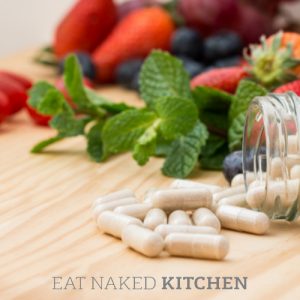Heading to the beach the other day with my friend, I asked, “How are you?” “Oh fine,” he said, “except I woke up in the middle of the night with the most outrageous cramp in my calf – I woke myself screaming out in pain! I guess I must be overdoing it with the exercise.” “Are you staying hydrated?” I asked. “I think so, but it’s been so hot, and I’m probably not getting enough – I should try and drink more.”
But is it just hydration? Or is it also his mineral balance?
This is a common scenario that I see with my clients, friends and family alike, and more often than not, it comes from our electrolytes being out of whack. Electrolytes are minerals and when they are out of balance, all kinds of things can happen in the body, from muscle cramps to osteoporosis.
Minerals come from the earth and are ultimately returned to the earth. They compose 4% of our body and must be obtained from the food we eat and the water we drink. We need only in minute amounts of minerals, and yet, their absence can result in disease conditions. Minerals work together synergistically to perform a variety of vital functions in the body – we need a whole team of them to work properly. Here’s a list of what they do for us:
- Maintain pH balance in the body. Too acidic or too alkaline? These minerals play a vital role.
- Facilitate the transfer of nutrients across cell membranes. Without minerals, that great dinner you just ate ain’t getting in.
- Maintain proper nerve conduction. This is one of your body’s key internal communication systems. Minerals are essential to signals being sent and received.
- Contract and relax muscles. There’s the reason for that muscle spasm.
- Regulate tissue growth. Without proper mineral balance, our bones and muscles suffer (osteoporosis anyone?)
- Provide structural functional support. Our skeleton is a mineral storehouse. Without it, well… we’d be a puddle.
 According to Lawrence Wilson, MD, who has done extensive research with minerals, there are 92 known stable mineral elements. Seven of these are “macro-minerals” or what you probably know of as electrolytes, and these are the most abundant in our bodies. Blood levels of these remain quite constant. If they vary even a little -especially the first four I’ve listed below – we can get very sick.
According to Lawrence Wilson, MD, who has done extensive research with minerals, there are 92 known stable mineral elements. Seven of these are “macro-minerals” or what you probably know of as electrolytes, and these are the most abundant in our bodies. Blood levels of these remain quite constant. If they vary even a little -especially the first four I’ve listed below – we can get very sick.
Calcium – the structural element: vital for strong bones and teeth, for the heart and nervous system, muscle growth and contraction. It’s essential for preventing acid-alkaline imbalances. Best usable sources of calcium are raw dairy products and bone broth.
Magnesium – the bright and shining mineral: essential for enzyme activity, calcium and potassium uptake, nerve transmission, bone formation and metabolism of carbohydrates and minerals. We can get magnesium from dairy, nuts, vegetables, fish, meat, seafood and kelp.
Sodium – the volatility and solvent mineral: essential to life, all body fluids contain sodium – it’s needed for many biochemical processes including water balance regulation, fluid distribution on either side of the cell walls, muscle contraction and expansion, nerve stimulation and acid-alkaline balance. It’s required for proper adrenal function. Meat broths and zucchini are excellent sources.
Potassium – the volatility and heart mineral: potassium and sodium work together – inner cell fluids are high in potassium while fluids outside the cell are high in sodium – thus potassium is essential for many reactions within the cell. It’s helpful in treating high blood pressure. It can be found in nuts, grains and vegetables.
Phosphorous – the most fiery mineral: second most abundant mineral in the body, it’s needed for bone growth, kidney function, cell growth and helps maintain acid-alkaline balance. While it’s found in many foods, for it to be usable in must be in correct balance with magnesium and calcium in the blood. Best sources: animal products, grains, legumes and nuts.
Sulfur – the fiery cleansing and joining mineral: aids in many biochemical processes and is part of the chemical structure of several amino acids (proteins); protects the body from infection, blocks harmful effects of radiation, pollution and slows the aging process. It can be found in cruciferous vegetables, eggs, milk and animal products.
Chloride – the cleanser: helps regulate acid-alkaline balance in the blood, passage of fluids across cell membranes and is needed for production of hydrochloric acid and therefore required for protein digestion. We find chloride in salt and lacto-fermented beverages (kombucha, beet kvass) and bone broths as well as celery and coconut.
In addition there are many minor minerals that are essential in trace amounts, the most important of which include: iron, cobalt, copper, zinc, chromium, silicon, boron, molybdenum, iodine and selenium.
As you can see, most of the macro minerals are involved in maintaining a perfect acid-alkaline balance in the body so that complex enzymatic reactions can occur, not the least of which is getting nutrients into and toxins out of the cell. In general, we humans tend to be more acidic because of the food and water we ingest. For example, meat, most fish and seafood, milk, eggs, cheese, coffee, tea, tap water, fats, and processed foods are all acidic, so the body is constantly trying to get back into balance so that we can function properly.
How does the body do that, if the food and water we take in is void of the minerals we need to create that balance? It starts leaching minerals from the bones, depleting our reserves. This is why it’s so important to eat organic whenever possible, so that the soil that your food is grown in has the greatest abundance of minerals available from the earth. The protein that we eat should be pasture-raised and wild as well, also benefitting from the mineral bounty the earth can offer.
The same goes for the water that everyone is telling us to drink! When we increase our fluid volume, we diminish the amount of minerals in that total volume, unless we add our own minerals to that volume. Here are the best ways I know to do that:
- Drink water that has been filtered and re-mineralized
- Drink Bone Broth – beef, chicken, or fish bones – it’s one of the healthiest and easiest ways to get minerals back into our body
- Add unrefined sea salt to your drinking water – most sea salts have anywhere from 75-85 different minerals in them depending where they come from. Adding a pinch of sea salt to your water makes it easier for our tissues to absorb the fluid.
So I made these suggestions to my friend and he started adding sea salt to the water he’s drinking and picked up some bone broth from his local butcher. Guess what? No more cramps!
These are a few of the ways that I know how to increase the minerals I take in everyday, but I’d love to know how you get your minerals through the food you eat and the water you drink – drop me a line below and share it with everyone at Eat Naked!








Do you know anything about the interreplacement between the minerals in maintaining health?
For example, does one mineral replace the balance of another mineral if one consumes too many supplements of eg magnesium.
With minerals it’s a very delicate balance, and yes if you consume too much of one mineral it can displace another and throw things off balance. I generally recommend that you supplement with a broad-spectrum multi-mineral rather than individual minerals unless you are working on something specific and being tested regularly to make sure you’re not throwing the balance off. With magnesium specifically, since it’s such a common deficiency, it’s one of the few that’s relatively safe to consume regularly as a single. It’s depleted by many things, including stress, so many people do supplement with it individually and aren’t at risk of throwing off the balance of other nutrients.
Thank you for this overview. Keeping the electrolytes in balance is a vital part of mind health, as well. Insufficient magnesium (and potassium and sodium, I believe) have been linked to depression and anxiety. Given how overmedicated our culture has become, it is truly a pity that more prescribers don’t reach for the bone broth instead of the anti-depressants.
Thanks again.
LOADS of spinach, kale, broccoli and lentils – you can’t go wrong! These truly are supper foods.
milk (atleast when pasturised) leaches minerals from the body
Thanks for this post,my question is,how do I educate people on mineral balance
Best way is to start small and specific. Focus on water and having people add a pinch of sea salt.
I drink at least 64 ounces of water per day. Do I put a pinch of sea salt in each 16 ounce bottle of water? I don’t have any reason to “watch my salt intake” but don’t want to over do it either.
Yes, just a pinch into each 16 oz. Not enough to affect the taste.